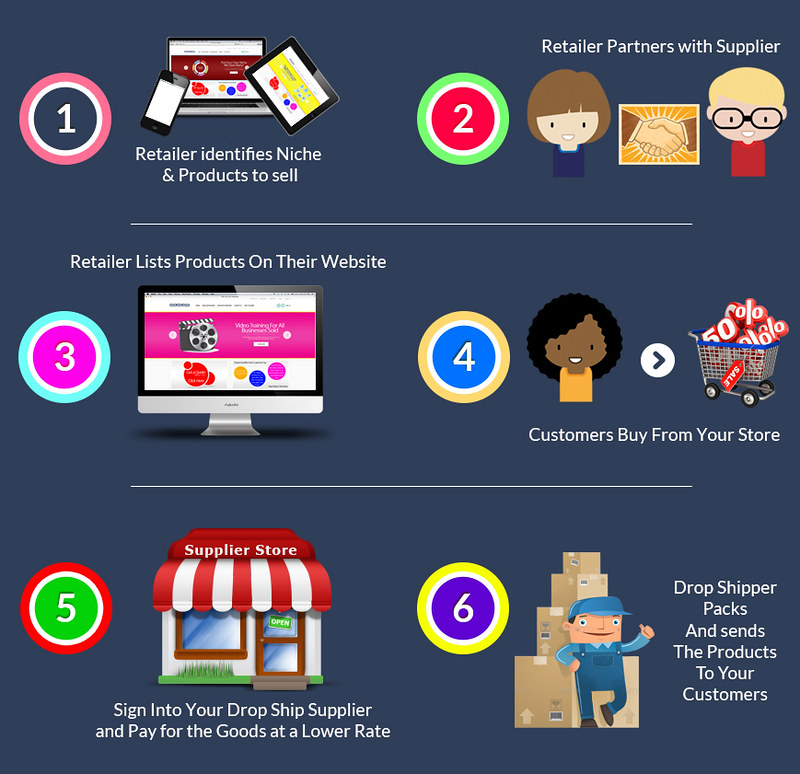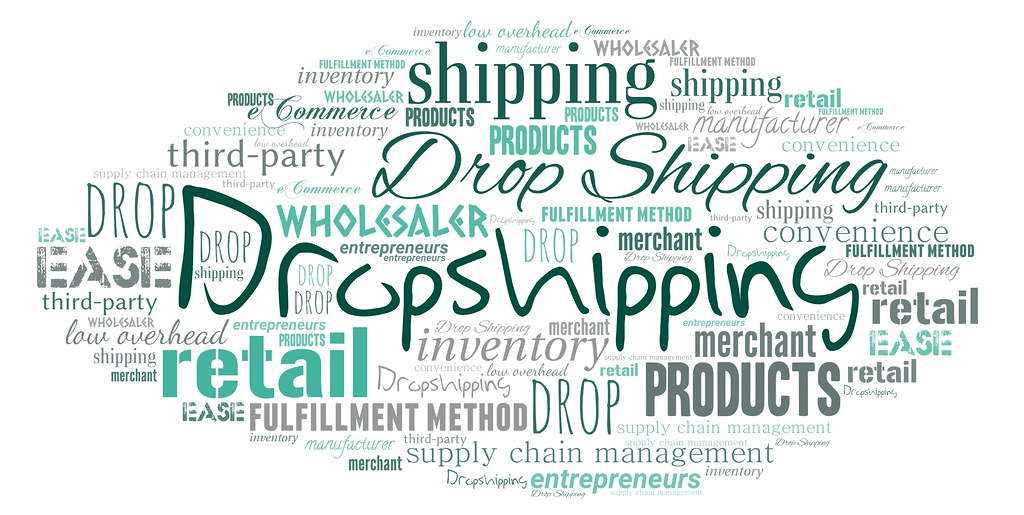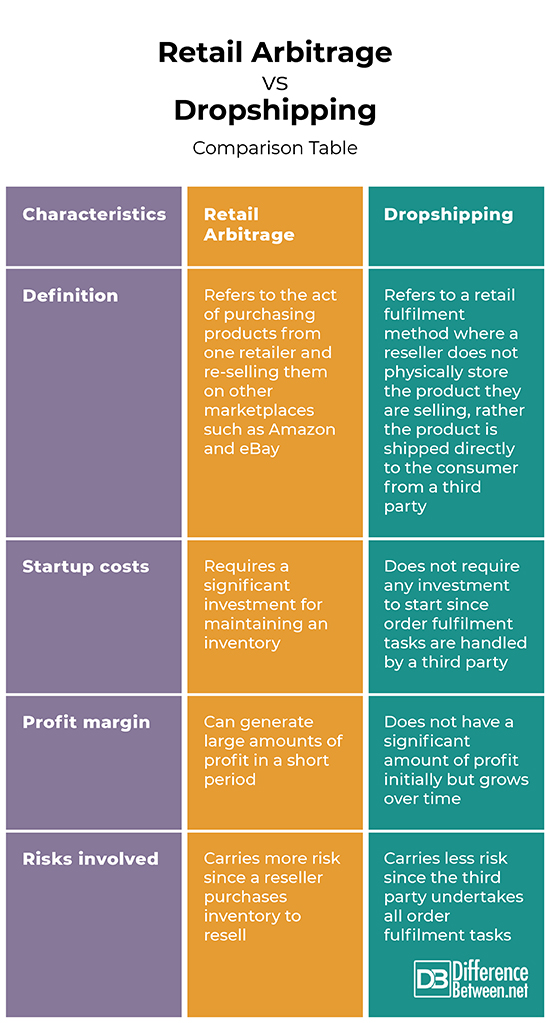Difference Between Retail Arbitrage and Dropshipping
eCommerce is one of the fastest developing business models globally, thanks to the vast technological innovations. While most businesses have embraced it, others are still stuck to traditional business methods. Luckily, there are many variations of eCommerce that businesses can adopt. For instance, most online businesses have embraced dropshipping. Retail arbitrage has also become popular, with most enterprises taking advantage of the trend. Let’s take a look at the differences between retail arbitrage and dropshipping as well as the pros and cons.

What is Retail Arbitrage?
This the act of purchasing products from one retailer and re-selling them on other marketplaces such as Amazon and eBay. In most instances, retail arbitrage involves the purchase of products in bulk when it is heavily discounted or on a clearance sale. Through a re-sale, a business person will then gain significant profit. What most people often ignore is that retail arbitrage is legal and is allowed in many online marketplaces such as Amazon. However, some products need approval from a manufacturer which can be a lengthy process.
Advantages of retail arbitrage include:
- Low entry threshold– Retail arbitrage has low entry costs. While costs such as investments in a product, payments on accounts, software packages and prices for the presenters should be factored in, the cost is still lower compared to that of starting a new business afresh.
- It can be a fast method to make money– This is the sole reason why most people engage in retail arbitrage.
- Ease of diversification– Retail arbitrage does not limit a business to any niche. As such, businesses easily manoeuvre the market and sell different products. This means that even in instances where there is a blunder in one product, a business can survive the market by focusing on other products.
Retail arbitrage has various disadvantages including:
- A reseller does not have control over supply- This means that if the marketplace does not have enough inventory, your business will be affected since you have no direct contact with the manufacturer.
- It does not build customer loyalty– Since resellers do not specialize in one brand or product category, building customer loyalty is difficult. Even if a large following is built, it could be lost if another cheaper product is not available.
- A reseller does not control the margins– Resellers are not in control of the product. In most cases, they have to accept a product at the given price.
- Bad inventory can cost a reseller- Purchasing bad inventory in bulk can lead to expenses that can be hard to recover from.

What is Dropshipping ?
This is a retail fulfilment method where a reseller does not physically store the product they are selling, rather the product is shipped directly to the consumer from a third party. In most cases, the third party is a manufacturer or a distributor. As such, the seller does not handle the product directly. Dropshipping has become a popular retail strategy in online businesses.
Here are the advantages of dropshipping.
- Low inventory cost– Inventory is the highest contributor to the startup costs in a business. With dropshipping, this cost is lowered since businesses only purchase what a customer wants. It also reduces the cost of obsolete inventory.
- Low startup costs– Dropshipping is the cheapest business model for entrepreneurs with limited capital. This is because a business that takes advantage of the business model can start operations with zero stock.
- The ability to sell and test many products with limited risk- Since entrepreneurs only purchase what a customer intends to buy, the risk of purchasing many products that may disappoint clients is eliminated.
- Low order fulfilment costs– Order fulfilment costs can be high especially when dealing with many products. This could be anything from the cost of renting a warehouse, tracking, organizing, packing and even shipping. Dropshipping lowers these costs as a third party takes care of all these tasks.
Despite the benefits, dropshipping has various cons.
- No control over lead times and order fulfilment– Since a third party handles all order fulfilment tasks, a business does not have control over these. As such, you may have many instances of customer discontent leading to non-repeat purchases. As such, dropshipping requires partnership with high-quality partners.
- Less profit– The cost of dropshipping is higher hence less profit. Entrepreneurs will most likely pay more for one or a few products compared to bulk purchases which in turn reduces the profit margin.
- Over-reliance on other people’s stock- While having the option of offering new items conveniently and promptly is inexpensive, you cannot control your supplier’s stock. This means that if they run out of stock, your business will also be affected. This can lead to long lead times not forgetting lost customers.
- Poor customer service– Issues such as late product deliveries, damages and wrong deliveries are common with dropshipping. If such issues, a business is more likely to lose the client to competitors due to these poor customer services regardless of who is at fault.
Similarities between Retail arbitrage and Dropshipping
- In both, resellers rely on third parties for inventory
- It is difficult to build a brand in both
Differences between Retail arbitrage and Dropshipping
Definition
Retail arbitrage refers to the act of purchasing products from one retailer and re-selling them on other marketplaces such as Amazon and eBay. On the other hand, dropshipping refers to a retail fulfilment method where a reseller does not physically store the product they are selling, rather the product is shipped directly to the consumer from a third party.
Start-up costs
While retail arbitrage requires a significant investment for maintaining an inventory, dropshipping does not require any investment to start since order fulfilment tasks are handled by a third party.
Profit margin
Retail arbitrage can generate large amounts of profit in a short period. However, dropshipping does not have a significant amount of profit initially but grows over time.
Risks involved
Retail arbitrage carries more risk since a reseller purchases inventory to resell. On the other hand, dropshipping carries less risk since the third party undertakes all order fulfilment tasks.
Retail arbitrage vs. Dropshipping: Comparison Table

Summary of Retail arbitrage and Dropshipping
Retail arbitrage refers to the act of purchasing products from one retailer and re-selling them on other marketplaces such as Amazon and eBay. It requires a significant investment for maintaining inventory and carries more risk. On the other hand, dropshipping refers to a retail fulfilment method where a reseller does not physically store the product they are selling, rather the product is shipped directly to the consumer from a third party. Resellers do not require any investment to start since order fulfilment tasks are handled by a third party. However, it does not have a significant amount of profit initially but grows over time. Despite the differences, both retail arbitrage and dropshipping are popular reselling methods.
- Difference Between Profit Center and Investment Center - July 2, 2022
- Difference Between Anti-Trust and Anti-Competition - June 6, 2022
- Difference Between Stocktaking and Stock Control - June 6, 2022
Search DifferenceBetween.net :
Leave a Response
References :
[0]Liam S. Parker. Selling on Amazon: Unlocking the Secrets to Successfully Generate a Long-Term Passive Income Business by Selling on Amazon. Isaac Cruz, 2018. https://books.google.co.ke/books?id=GZySDwAAQBAJ&pg=PT9&dq=Difference+between+Retail+arbitrage+and+Dropshipping&hl=en&sa=X&ved=2ahUKEwjLycaymuzwAhVggf0HHY4sBzU4ChDoATAJegQICxAC#v=onepage&q=Difference%20between%20Retail%20arbitrage%20and%20Dropshipping&f=false
[1]John Navarro. Retail Arbitrage 101. Shh Publishing, 2015. https://books.google.co.ke/books?id=zecBCwAAQBAJ&pg=PT3&dq=retail+arbitrage&hl=en&sa=X&ved=2ahUKEwj_5svMmuzwAhWu8bsIHVNvAOsQ6AEwAXoECAsQAg#v=onepage&q=retail%20arbitrage&f=false
[2]Chandler Wright. Dropshipping: Mastery - How to Make Money Online and Create $10,000+/Month in Passive Income with Ecommerce Using Shopify, Affiliate Marketing, Blogging, SEO, and Social Media Marketing. SD Publishing LLC, 2021. https://books.google.co.ke/books?id=81UXEAAAQBAJ&pg=PT65&dq=Dropshipping&hl=en&sa=X&ved=2ahUKEwiuprHFmuzwAhXZgf0HHW-vCC4Q6AEwA3oECAsQAg#v=onepage&q=Dropshipping&f=false
[3]Image credit: https://live.staticflickr.com/65535/48495720977_2ee1a1b9fc_b.jpg
[4]Image credit: https://live.staticflickr.com/4702/26096405318_4327e4d7c0_c.jpg
